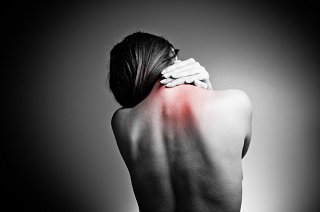Upper Left vs Upper Right Back Pain
Significance of One-sided Upper Back Pain

Suffering from Upper right back pain OR Upper Left Back Pain?
One-sided Upper back pain is a very common presentation at my physiotherapy clinic. The type of person I see most with upper right back pain is a sedentary worker who is right-handed. The type of person I see most with upper left back pain is a sedentary worker who is left-handed.
One Sided of back pain can originate from many places, but the most common causes of one-sided upper back pain which I see are:
- Lack of good posture - particularly while sitting and working.
- Trapped nerves.
- Prolapsing discs.
- Tight muscles.
- Heart referral.
Your posture is often the cause of one sided back pain
The main underlying cause of one-sided upper back pain with my clients is a poor sitting posture at their desk or computer OR while doing a job that involves a lot of driving. Taxi drivers and other driving professions often also present with posture-related upper back pain.
When you sit in a poor posture for days at a time, and combine that with using one hand or one side repetitively in this position - something in your upper back will eventually breakdown and result in pain!
Poor postural habits - when adopted over time - may also cause some muscles to tighten and other muscles to weaken. This imbalance - often between your left and right side - may result in your upper back pain. Poor posture may also place excess pressure on discs and nerves causing breakdown in these structures and pain. So, understanding the cause of your upper back pain is a necessity in the management and removal of your pain.
Let’s consider driving - if your shoulders are curled forwards and your upper back is rounded, then you will be straining your neck and upper back to see your computer screen, or to look out the window when driving.
Over time, this type of posture will result in muscle, joint and ligament strain with the associated pain.
Left sided upper back pain - check your heart!
More serious causes of upper left back pain relate to your heart. It is common to have left arm, chest and upper back pain symptoms with heart-related conditions. Have your heart checked regularly is my advice and never ignore the symptoms of left-sided upper body pain.
Sponsored links
Treating one sided back pain
The treatment of one-sided upper back pain is to primarily address the cause.
In most clients that I see, this involves active posture correction and adjusting your work station/driving position to be more ergonomically acceptable. Following that, your tight muscles or impinged nerves may require some attention using manual therapy techniques.
However, inn most cases, the correction of your posture is the real key in long term resolution of your upper back pain. If you only do manual therapy and do not address poor posture then the chances of a re-occurrence is very high indeed.
Initially, you may find that your upper back pain eases after a nights rest. This is common. However, if you choose to ignore the cause of your pain then it may eventually become more severe until a nights rest offers no recovery. Unfortunately, I see this pattern with my clients on a daily basis.
“If only you would react to your body’s calls as they present themselves rather than waiting till the pain is very bad…” - is a common line I hear myself thinking as clients present with long histories of upper back pain, which they have ignored until it eventually affects their work and life performance.
Prevention is always better than cure!!! For any upper back symptoms not resolving fully within one week I advise you to seek expert help.
DISCLAIMER
While the content and materials contained in the articles on this website have been written & researched by Sally Ann Quirke, a professional, practising & fully qualified Chartered Physiotherapist (Physical Therapist) based in Ireland, they are provided for general information and educational purposes only. They do not constitute medical advice on any particular individual situation. Please see your Chartered Physiotherapist or other medical practitioner for full and individual consultation.
Please read the full disclaimer here.
Cookies and Privacy
By using this website, you consent to the use of cookies in accordance with our cookie policy. For more information on how we use cookies, please read our cookie policy here.
